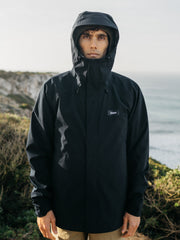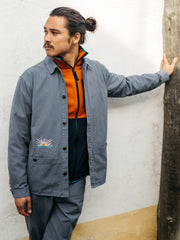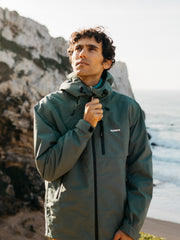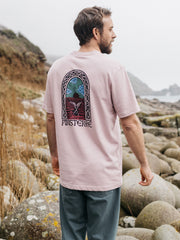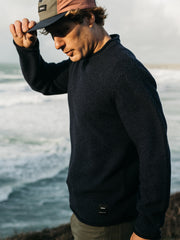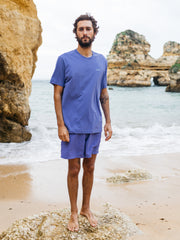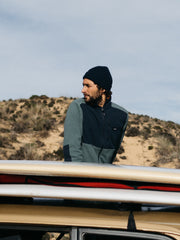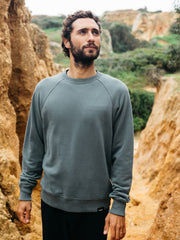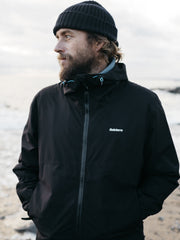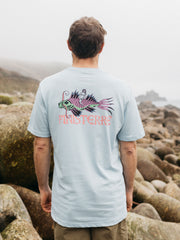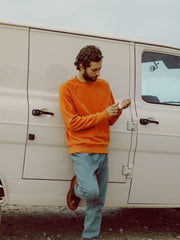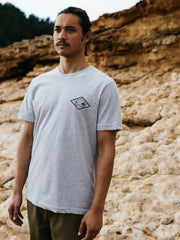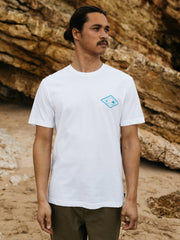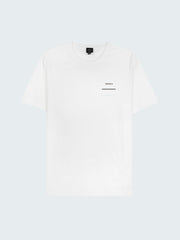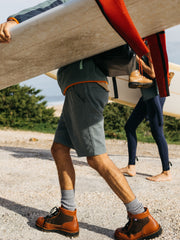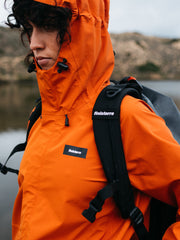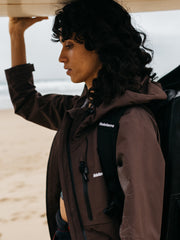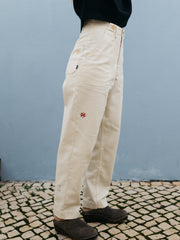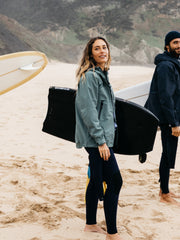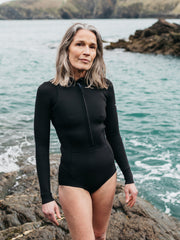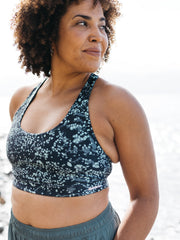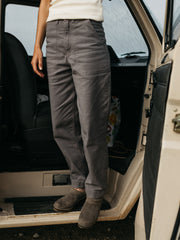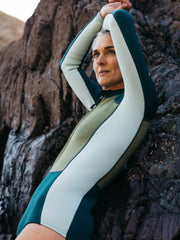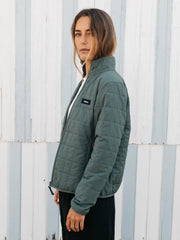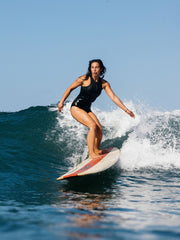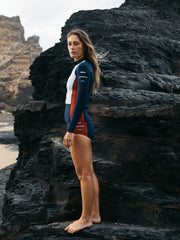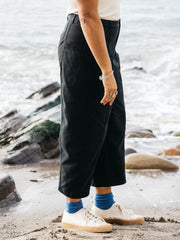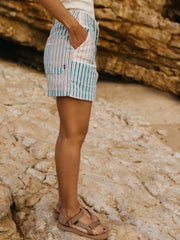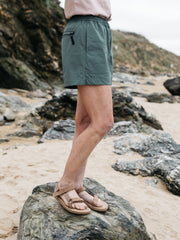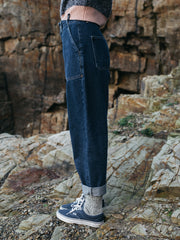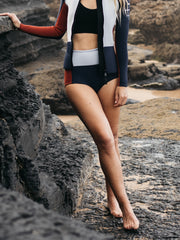Peter Matthews’ work is all about the sea. He immerses himself and his artworks in the water, experiencing the haptic feedback of the ocean to create works that are from the sea, of the sea, and by the sea. Peter’s deep connection with the ocean made for a natural alignment with our own values and the perfect person to work with to bring you our first ever Artist Collection.
The Ocean's Brush | In Conversation With Peter Matthews
07.12.19
4 min read
Written by Zak Rayment
Image by Abbi Hughes
Your style of artwork and the way you produce it is unique. What was your motivation behind working in this way? Was there a particular moment in time that initiated the first foray into the ocean, to draw or paint?
If I can draw from one particular thing that it all sprouts from, it’s probably my time surfing. I got into surfing in about 2005 and when I was living on the Pacific Coast of Mexico. When you’re surfing you’re not actually – well, for me at least – you’re not really thinking about anything. And I think that’s where a lot of surfers feel that same pulling, where you just kind of let go of something from dry land and you leave all of your worries or concerns. You leave that behind, and I think that’s where surfing, for me, allows you to see things really clearly. It’s almost like having the windscreen wipers of reality on. You can see much more clearly. I think that time was when I started to put it all together in a way that was ‘art’. That’s also when I got into drawing, because I felt that drawing and surfing were actually on the same parallel as each other; you’re essentially going out in to a state or a different time and you’re trying to catch something which is essentially elusive. It’s a spiritual thing really.
I often think back to an incident that happened in Mexico, when I had a near-death experience, surfing. I think it was a kind of epiphany really. I was surfing down near Oaxaca in southern Mexico and I was out in quite big waves and a huge set came in. It broke the leash to the board and I was left just floundering out there. And another really big set of waves came in…
It was the kind of moment where one’s life gets very close to that astral voyage that we all take, one day, but I suppose we never know when that ‘one day’ will be. It was a very… mixed emotional experience. Because, although I was very, very scared, there was also a period of time where I wasn’t. I think it was that moment, where everything was really clear and peaceful and beautiful, that it dawned on me that I could make something from that experience.
You have continued to work directly in the ocean for a number of years now. How do you believe your working style benefits your art? Does it help you to feel more connected to the ocean when you are working?
For me, I never really think about painting or drawing in terms of making something visual. The visual stuff that comes from the experience of producing work is really secondary to that lived experience. And I suppose the art is just a visual embodiment of what is a very personal, very direct, very visceral, live experience of being in the water or in nature.
Going from drawing, which is perhaps just a hand and eye relationship or a co-ordination between the visual and the hand. Going from that into what is a hyper-real world, where your whole body becomes an instrument. It’s always been about that subject and object relationship for me, where the subject (the ocean) and the thing (the drawing) act in a kind of symbiosis, where they work each other out.
So the ocean is a big part in making it real, more so than me really. I may write words that come to my mind or draw lines and shapes, which are my own attempt to record what’s happening in that live time. But then the ocean will also take that away, it’ll wash it away. It’s almost a balance between being mindful and being mindless. Nothing is really forced, or pressured, it just naturally draws itself through time, very organically.
The way you talk about your connection with the sea is very powerful. Would you say that you try and pour that ocean connection into your work, so that others can experience it as well? How much, would you say, is your work about sharing that ocean connection with others?
I think all art is a very personal experience. What I see is not what someone else sees or feels. And I think that’s one of the beautiful things about it. Art can effect or touch people in a myriad of different ways. Recently, for the Maritime Museum piece I spoke to all kinds of people about the ocean – young people and old people – and my message there was that we only really take care of something or protect something when we love it. I think that’s perhaps my overall message, rather than anything academic, and that’s what I try to say; if we want to protect the ocean, that comes from loving the ocean first.
There’s also a lot of things beyond just being in the ocean and enjoying that beautiful place. I think more so every year that it’s also a place where we can purge ourselves of all the uncertainty of what life is now and get back to who we truly are. We hear about this quite a lot in the news and other places; that being in the ocean or walking on the beach, or drawing a feeling or something (like I do), is a great way to stabilise and maintain a good mental health balance in your life, so I think that’s a huge part of it too.
You talk about working alone in the ocean and the solitude… What is it about being alone in that environment that helps your process? (And what level of preparation is needed when planning an expedition?)
Well, when I’m down in Cornwall I’m pretty used to it. I know the beaches well and I know where to make a cache of food in the rocks. I know where to get water from, from springs and things like that. But the other trips that I take, to Chile and Mexico for example, trips that involve a lot of travel and planning, those are harder. There’s part of me which is 50% planned and then there’s the other part of me that’s really not planned at all. It’s just about embracing that uncertainty and drawing on a catalogue of experiences on how to adapt and survive. A lot of it is about talking to local people. The Military has a term that I quite like, that’s where they are trying to find the truth of the place by just being there; watching it and talking to the local people. There is a lot of planning involved, just basic stuff like where to get water and things like that.
I often think to myself, “Why do I go to these places?” It’s not about being anti-social and cutting myself off from civilisation at all. It’s more about being alone. When you’re alone you experience things much more strongly. Not always, but most of the time. And I suppose I’m always curious about exploring, which I think is what surfers do as well. They always want to discover new surf breaks and try out new parts of the ocean. So I guess I’m just curious really.
Most recently, the places I’ve been have also been ways of healing myself. With personal bereavements and things like that. I don’t really talk about that part of things too much but it really does help. It’s those places where there are big skies and vast, vast stretches of beach where there’s nothing, but everything. And that’s maybe a Zen or Taoist thing that has affected me from travelling; it’s that going out into nothing, but at the same time experiencing everything.
Just one final question for you before we wrap up. We tend to ask this to most people we work with because it’s deeply linked to our purpose as a company. So, what do you feel that your connection to the ocean gives you in your daily life?
It’s a companion. It’s given me direction. It’s healing. It’s a strength that we draw from; peace, serenity, the unknown. It feeds curiosity. It’s also just such a powerful tonic that seems to make everything right again. And it doesn’t matter however bad you feel or whatever tragic things happen in life, the good, the bad and the ugly, it’s always there. So that’s my answer; it’s a tonic, it works and it’s always there. Always.


